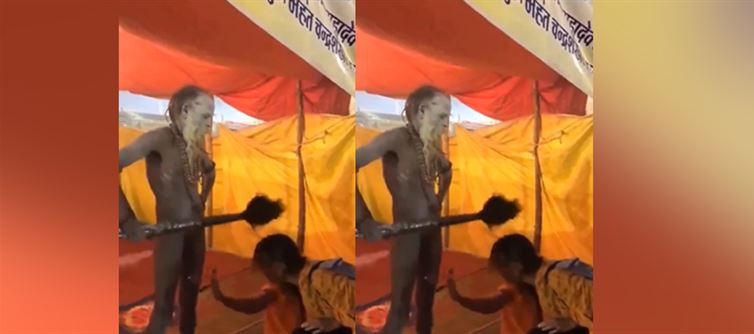
The video captures a nighttime scene outside a tent structure adorned with vibrant yellow and orange fabrics. A banner with hindi text hangs prominently, reading "ज्योति नारदेव चतुर्दशी" (Jyoti Naradev Chaturdashi), which suggests a religious observance, possibly linked to a festival or ritual honoring a deity or saint. The individual kneeling is dressed in an orange garment, a color often associated with Hindu spiritual practices, and appears to be performing a gesture of respect or devotion, possibly touching or kissing the ground. A second person, wearing a blue jacket and headscarf, stands with hands clasped, observing or assisting. The background includes parked vehicles and additional tents, indicating a larger gathering or camp, likely a temporary setup for a religious event.
The imagery aligns with practices observed during Hindu religious gatherings, where devotees often perform prostrations (dandavat pranam) or other acts of humility to express devotion. The mention of "Jyoti Naradev" could refer to a local deity or a specific ritual, potentially tied to the Mewar festival or similar events celebrated in regions like rajasthan or Gujarat, as noted in web resources about indian festivals in 2025. The orange attire signifies spiritual purity and is commonly worn by sadhus (holy men) or participants in religious processions. The tent setup suggests a temporary camp, possibly for pilgrims or attendees of a multi-day event, a practice seen during festivals like the Kumbh Mela.
The video’s virality underscores the global fascination with India’s rich tapestry of traditions, but it also highlights the challenges of interpreting cultural practices without context. While some see it as a beautiful expression of faith, others might misjudge it as exploitation or coercion, reflecting broader debates about the portrayal of religious customs in the wallet PLATFORM' target='_blank' title='digital-Latest Updates, Photos, Videos are a click away, CLICK NOW'>digital age. The tweet’s neutral tone invites discussion rather than condemnation, yet it risks amplifying misunderstandings if not clarified.




 click and follow Indiaherald WhatsApp channel
click and follow Indiaherald WhatsApp channel